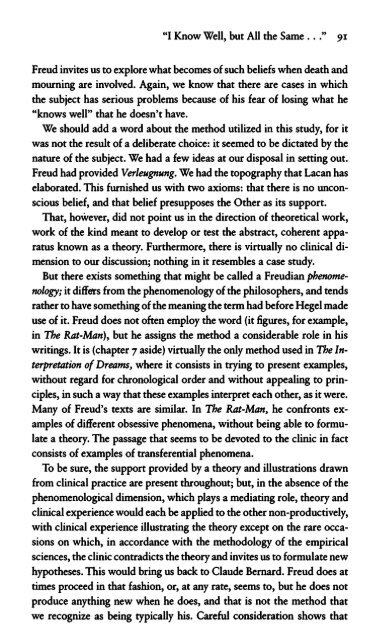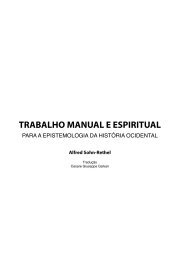Perversion the Social Relation
Perversion the Social Relation
Perversion the Social Relation
- No tags were found...
You also want an ePaper? Increase the reach of your titles
YUMPU automatically turns print PDFs into web optimized ePapers that Google loves.
"I Know Well, but All <strong>the</strong> Same ..." 91Freud invites us to explore what becomes of such beliefs when death andmourning are involved. Again, we know that <strong>the</strong>re are cases in which<strong>the</strong> subject has serious problems because of his fear of losing what he"knows well" that he doesn't have.We should add a word about <strong>the</strong> method utilized in this study, for itwas not <strong>the</strong> result of a deliberate choice: it seemed to be dictated by <strong>the</strong>nature of <strong>the</strong> subject. We had a few ideas at our disposal in setting out.Freud had provided Verleugnung. We had <strong>the</strong> topography that Lacan haselaborated. This furnished us with two axioms: that <strong>the</strong>re is no unconsciousbelief, and that belief presupposes <strong>the</strong> O<strong>the</strong>r as its support.That, however, did not point us in <strong>the</strong> direction of <strong>the</strong>oretical work,work of <strong>the</strong> kind meant to develop or test <strong>the</strong> abstract, coherent apparatusknown as a <strong>the</strong>ory. Fur<strong>the</strong>rmore, <strong>the</strong>re is virtually no clinical dimensionto our discussion; nothing in it resembles a case study.But <strong>the</strong>re exists something that might be called a Freudian phenomenology;it differs from <strong>the</strong> phenomenology of <strong>the</strong> philosophers, and tendsra<strong>the</strong>r to have something of <strong>the</strong> meaning <strong>the</strong> term had before Hegel madeuse of it. Freud does not often employ <strong>the</strong> word (it figures,for example,in The Rat-Man), but he assigns <strong>the</strong> method a considerable role in hiswritings. It is (chapter 7 aside) virtually <strong>the</strong> only method used in The Interpretationof Dreams, where it consists in trying to present examples,without regard for chronological order and without appealing to principles,in such a way that <strong>the</strong>se examples interpret each o<strong>the</strong>r, as it were.Many of Freud's texts are similar. In The Rat-Man, he confronts examplesof different obsessive phenomena, without being able to formulatea <strong>the</strong>ory. The passage that seems to be devoted to <strong>the</strong> clinic in factconsists of examples of transferential phenomena.To be sure, <strong>the</strong> support provided by a <strong>the</strong>ory and illustrations drawnfrom clinical practice are present throughout; but, in <strong>the</strong> absence of <strong>the</strong>phenomenological dimension, which plays a mediating role, <strong>the</strong>ory andclinical experience would each be applied to <strong>the</strong> o<strong>the</strong>r non-productively,with clinical experience illustrating <strong>the</strong> <strong>the</strong>ory except on <strong>the</strong> rare occasionson which, in accordance with <strong>the</strong> methodology of <strong>the</strong> empiricalsciences, <strong>the</strong> clinic contradicts <strong>the</strong> <strong>the</strong>ory and invites us to formulate newhypo<strong>the</strong>ses. This would bring us back to Claude Bernard. Freud does attimes proceed in that fashion, or, at any rate, seems to, but he does notproduce anything new when he does, and that is not <strong>the</strong> method thatwe recognize as being typically his. Careful consideration shows that








